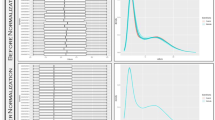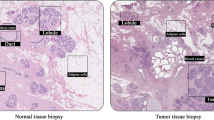Abstract
Objective
The purpose of this study was to construct the breast cancer gene regulatory networks through the high-throughput techniques and optimize the drug target genes of breast cancer using bioinformatics analysis, and thus accelerate the process of drug development and improve the cure rate of breast cancer.
Methods
The gene expression profile data of breast cancer were downloaded from GEO database and the transcriptional regulation data were obtained from UCSC database. Then we identified the differentially expressed genes (DEGs) by SAM algorithm and built gene regulatory networks by the supervised algorithm SIRENE. Finally, the drug targets of the DEGs with changed regulation relations were optimized based on the CancerResource database.
Results
A total of 584 DEGs were identified and the gene regulatory networks in the normal state and tumorous state were constructed. By comparing the new predicted regulatory relation in cancer state and normal state, the regulatory relation of 18 genes was found to be changed in the two states, showing the possibility to be applied as drug target genes. After the searches in the CancerResources, 7 genes were screened as the drug target genes, such as PFKFB3.
Conclusion
Our present findings shed new light on the molecular mechanism of breast cancer and provide some drug targets which have the potential to be used in clinic for the treatment of breast cancer in future.



Similar content being viewed by others
References
Siegel R, Naishadham D, Jemal A (2013) Cancer statistics, 2013. CA Cancer J Clin 63(1):11–30
Levin AO (2013) The impact of reduced ovarian function and its consequences on young women survivors of breast and gynecologic cancer. In: The Ohio State University
Bleyer A, Welch HG (2012) Effect of three decades of screening mammography on breast-cancer incidence. N Engl J Med 367(21):1998–2005
Siegel R, DeSantis C, Virgo K, Stein K, Mariotto A, Smith T, Cooper D, Gansler T, Lerro C, Fedewa S (2012) Cancer treatment and survivorship statistics, 2012. CA Cancer J Clin 62(4):220–241
Stephens PJ, Tarpey PS, Davies H, Van Loo P, Greenman C, Wedge DC, Nik-Zainal S, Martin S, Varela I, Bignell GR (2012) The landscape of cancer genes and mutational processes in breast cancer. Nature 486(7403):400–404
Reis-Filho JS, Pusztai L (2011) Gene expression profiling in breast cancer: classification, prognostication, and prediction. Lancet 378(9805):1812–1823
Weigelt B, Baehner FL, Reis-Filho JS (2010) The contribution of gene expression profiling to breast cancer classification, prognostication and prediction: a retrospective of the last decade. J Pathol 220(2):263–280
Goldhirsch A, Wood W, Coates A, Gelber R, Thürlimann B, Senn H-J (2011) Strategies for subtypes—dealing with the diversity of breast cancer: highlights of the St Gallen international expert consensus on the primary therapy of early breast cancer 2011. Ann Oncol 22(8):1736–1747
Cheng F, Liu C, Jiang J, Lu W, Li W, Liu G, Zhou W, Huang J, Tang Y (2012) Prediction of drug-target interactions and drug repositioning via network-based inference. PLoS Comput Biol 8(5):e1002503
Chuang H-Y, Lee E, Liu Y-T, Lee D, Ideker T (2007) Network-based classification of breast cancer metastasis. Mol Syst Biol 3(1):140
Barrett T, Suzek TO, Troup DB, Wilhite SE, Ngau W-C, Ledoux P, Rudnev D, Lash AE, Fujibuchi W, Edgar R (2005) NCBI GEO: mining millions of expression profiles—database and tools. Nucleic Acids Res 33(suppl 1):D562–D566
Pau Ni IB, Zakaria Z, Muhammad R, Abdullah N, Ibrahim N, Aina Emran N, Hisham Abdullah N, Syed Hussain SNA (2010) Gene expression patterns distinguish breast carcinomas from normal breast tissues: the Malaysian context. Pathol Res Pract 206(4):223–228
Karolchik D, Hinrichs AS, Kent WJ (2011) The UCSC genome browser. Curr Protoc Hum Genet: 18. 16. 11–18. 16. 33
Larsson O, Wahlestedt C, Timmons JA (2005) Considerations when using the significance analysis of microarrays (SAM) algorithm. BMC Bioinformatics 6(1):129
Butte AJ, Kohane IS (2000) Mutual information relevance networks: functional genomic clustering using pairwise entropy measurements. In: Pac Symp Biocomput. pp 418–429
Faith JJ, Hayete B, Thaden JT, Mogno I, Wierzbowski J, Cottarel G, Kasif S, Collins JJ, Gardner TS (2007) Large-scale mapping and validation of Escherichia coli transcriptional regulation from a compendium of expression profiles. PLoS Biol 5(1):e8
Margolin AA, Nemenman I, Basso K, Wiggins C, Stolovitzky G, Favera RD, Califano A (2006) ARACNE: an algorithm for the reconstruction of gene regulatory networks in a mammalian cellular context. BMC Bioinformatics 7(Suppl 1):S7
Langfelder P, Horvath S (2008) WGCNA: an R package for weighted correlation network analysis. BMC Bioinformatics 9(1):559
D’haeseleer P, Liang S, Somogyi R (2000) Genetic network inference: from co-expression clustering to reverse engineering. Bioinformatics 16(8):707–726
Irrthum A, Wehenkel L, Geurts P (2010) Inferring regulatory networks from expression data using tree-based methods. PLoS One 5(9):e12776
De Jong H (2002) Modeling and simulation of genetic regulatory systems: a literature review. J Comput Biol 9(1):67–103
Smoot ME, Ono K, Ruscheinski J, Wang P-L, Ideker T (2011) Cytoscape 2.8: new features for data integration and network visualization. Bioinformatics 27(3):431–432
Ahmed J, Meinel T, Dunkel M, Murgueitio MS, Adams R, Blasse C, Eckert A, Preissner S, Preissner R (2011) CancerResource: a comprehensive database of cancer-relevant proteins and compound interactions supported by experimental knowledge. Nucleic Acids Res 39(suppl 1):D960–D967
Verdoodt B, Vogt M, Schmitz I, Liffers S-T, Tannapfel A, Mirmohammadsadegh A (2012) Salinomycin induces autophagy in colon and breast cancer cells with concomitant generation of reactive oxygen species. PLoS One 7(9):e44132
Zhao D-D, Zhu Z-Y, Zhang C-F (2007) Advance in the development of target medicines for treatment of breast cancer. China Trop Med 4:70
Bentrem D, Gaiha P, Jordan V (2003) Oestrogens, oestrogen receptors and breast cancer. Eur J Cancer Suppl 1(1):1–12
Tonon G (2008) From oncogene to network addiction: the new frontier of cancer genomics and therapeutics. Future Oncol 4(4):569–577
Ahmad F, Deris S, Othman N (2012) The inference of breast cancer metastasis through gene regulatory networks. J Biomed Inform 45(2):350–362
Gupta PB, Onder TT, Jiang G, Tao K, Kuperwasser C, Weinberg RA, Lander ES (2009) Identification of selective inhibitors of cancer stem cells by high-throughput screening. Cell 138(4):645–659
Fuchs D, Heinold A, Opelz G, Daniel V, Naujokat C (2009) Salinomycin induces apoptosis and overcomes apoptosis resistance in human cancer cells. Biochem Biophys Res Commun 390(3):743–749
Demicheli R, Coradini D (2011) Gene regulatory networks: a new conceptual framework to analyse breast cancer behaviour. Ann Oncol 22(6):1259–1265
Baca-López K, Mayorga M, Hidalgo-Miranda A, Gutiérrez-Nájera N, Hernández-Lemus E (2012) The role of master regulators in the metabolic/transcriptional coupling in breast carcinomas. PLoS One 7(8):e42678
Conflict of interest
None.
Author information
Authors and Affiliations
Corresponding author
Rights and permissions
About this article
Cite this article
Xie, Y., Wang, R. & Zhu, J. Construction of breast cancer gene regulatory networks and drug target optimization. Arch Gynecol Obstet 290, 749–755 (2014). https://doi.org/10.1007/s00404-014-3264-y
Received:
Accepted:
Published:
Issue Date:
DOI: https://doi.org/10.1007/s00404-014-3264-y




